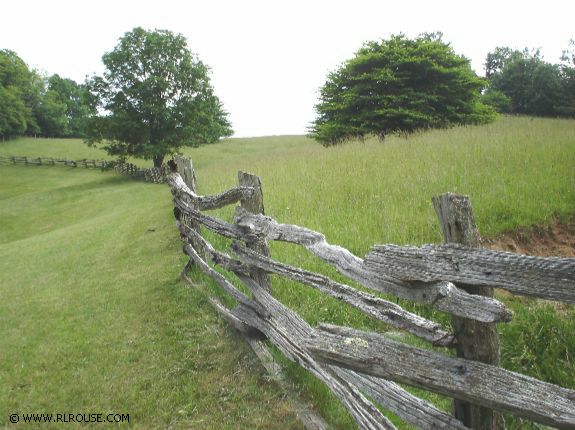|
Picture of the day - July 11, 2005
An Old Chestnut Split-Rail Fence

Back when America was young and expanding westward, timber was plentiful. And
one of the most plentiful trees of all along the Appalachian
Mountain Range was the American Chestnut. Lumber cut from American Chestnut
trees was called "wormy chestnut" because of all the distinctive worm
holes in the planks.
Wormy Chestnut lumber was a primary building material back then for several
reasons. It was very resistive to decay, light-weight, and easy to work with.
Also, the vast number of virgin American Chestnut trees that populated the
Appalachian forests provided cheap lumber that was readily available in amazing
widths. In fact, it's relatively easy to find wormy chestnut boards that can be
measured in feet, not just inches!
As a result, countless homes and barns
were built out of wormy chestnut lumber. There were also many thousands of miles
of split-rail fences built out of wormy chestnut logs.
But the first decade of the 20th century started a downward spiral that would
eventually bring an end to the availability of new wormy chestnut lumber - in
fact the very existence of living American Chestnut trees would soon be no
more...
In 1904, the American Chestnut trees started being attacked by chestnut blight.
The blight spread at an unstoppable rate, and within 50 years virtually all of
the American Chestnuts had succumbed to it.
The demise of this wonderful tree had devastating effects on the residents of
the Appalachian Mountain region. After the remaining Chestnut trees had been
harvested, there was no more new wormy chestnut lumber to be found. Even worse,
there would be no more of the tasty chestnuts that had been a dietary staple of
the Appalachian people. The chestnuts had always been harvested and stored for
consumption during the winter months, and they were even bartered and used as a
form of "money" in the poorest regions.
The loss of the American Chestnut trees also dealt a heavy blow to the wildlife
living along the Appalachian range. Squirrels, bear, deer and many other animals
had depended on the plentiful chestnuts for food, but that bounty came to an end
when the Chestnut trees were no longer producing the nuts. The animals had to
adapt, and adapt quickly. Many of them didn't make it, and the ones that did had
to learn to enjoy a new diet.
Wormy chestnut lumber can still be found today in the form of used and recycled
wood products. The lumber from those stately old trees is remarkably durable,
and many old barns are still covered with wormy chestnut planking. There is an
active market in which the barns are sold off, torn down, and the precious
lumber sold at a premium price - just another sad chapter in a long, sad story.
And although rare in today's America, there are still some old chestnut
split-rail fences to be found, especially at historic venues along the
Appalachian range and the Blue Ridge Parkway. One such fence is the focus of
today's picture. You'll find it located on the grounds of southwestern
Virginia's Grayson
Highlands State Park.
Picture Of The Day Homepage | Submit
a photo
Interesting Articles
|
|